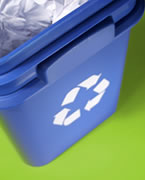Step 1: Get management support
Get management's support for your recycling program to ensure it
will be successful. Highlight the importance of recycling and show
your management how a recycling program will benefit your company
by:
Saving money through avoided disposal costs
Improving the public image of your company by saving natural resources
Improving employee morale–everyone wants to 'do the right thing'–recycle!
Show management the "waste problem" in your company and
how much material could be recycled instead of disposed; support
this by presenting your company's current garbage disposal practices
and costs. Develop a preliminary plan to present to management to
demonstrate how establishing a recycling program would be both feasible
and beneficial.
Step 2: Determine what materials to target for recycling
Look at your company's waste stream for recyclable material. Walk
through different areas of your facility and observe where and how
materials are generated in your business. The most commonly targeted
materials are paper, cardboard, can and bottles, but don't overlook
pallets, packing material, and office equipment. If you find materials
that aren't recyclable, try to find ways to prevent them from being
thrown away in the first place!
Start at a feasible level. Focus your recycling program on the largest
volume of waste materials being thrown away. For example, if you
work in an office, start by setting up a program to recycle paper
and cardboard. After your initial program is working well, add recycling
programs for other materials in phases. Build on your successes over
time.
Step 3: Find a recycling company to collect the materials
Based on the materials you decide to target for recycling, ask your
garbage hauler if they will collect and recycle these items, check
our Where to Recycle Database for an appropriate recycler or call
the RecyleWorks Hotline at 1–888–442–2666 for help. Don't forget
that you can use different vendors for different materials. If one
vendor won't pick up all your recyclables, you can use multiple recyclers.
Step 4: Decide where to place recycling collection containers
Recycling containers should be placed wherever materials are generated.
Commonly, this means at each work station and at centralized locations
throughout your facility, such as next to copiers and printers or
in break rooms. A good rule to follow is this: wherever there's a
garbage bin, place a recycling container next to it. Prominently
label the containers to avoid confusion.
Decide how materials will be moved out of the facility for pick–up
by the recycler. It is very important to involve your custodial service
in this process. Getting their input and buy–in is crucial to the
success of your program. Point out that, in most offices, after a
paper and cardboard recycling program has been implemented, there
is very little "garbage" remaining.
There are a variety of options for collecting material in a facility.
These are some methods that other companies currently use:
Custodians collect garbage and recyclables from each work station,
either daily or on alternate days.
Employees take recyclables to centralized location, and custodians
take garbage from work station.
Custodians pick up recyclables and employees empty their own garbage.
Decide what option works best for your employees and custodial service
that is also within any contractual or union agreements.
Step 5: Educate the employees
Train everyone on your new recycling program! Write a recycling
kick–off memo or email all employees to educate them about your new
recycling program. Education can also be achieved through motivational
posters and progress reports. Make sure your recycling program is
part of new employees' orientation training. Don't forget to educate
the custodial staff as well.
Provide incentives and reward participation. Generate enthusiasm
for your recycling program by distributing promotional items to those
who participate. Reminders about the program should be sent out periodically
to maintain participation.
Download the Sample Announcement Memo in Word document (20 KB ).
Step 6: Monitor the program
Monitor your recycling program and highlight positive results in
your company newsletter or email your employees to let them know
about program successes.
Monitoring the recycling program has important benefits. First,
it can help you determine where improvements, if any, are needed.
Also, it helps show the program's success, and thus build momentum
among upper management and employees. In most cases, precision is
not necessary and reasonable estimates of recycled material can be
very useful for gauging progress.
There are several ways to gather data to measure your program's
success. Ask for tonnage or volume reports from your recycler(s)
and garbage hauler and solicit input from employees. People using
the program will offer useful recommendations and ideas for improvement.
Quantify the success of the program as amount of resources saved,
pollution prevented, or dollars saved for the company. Remember that
for every ton of paper your company recycles, 17 trees are saved.
Some companies list the number of trees their company has saved on
an annual basis in their newsletter or email.
Every time a ton of paper is recycled, you've helped save 17 trees,
7000 gallons of water, 4 barrels of oil, and you've reduced air pollution
by 60 pounds.
Sample memos:
Download the Reminder Memo in Word document (22 KB ).
Download the Achievement Memo in Word document (20 KB ).
Step 7: Promote other waste reduction ideas in your company
Promote waste prevention and re–use of materials and encourage the
purchase of recycled–content supplies.
|

